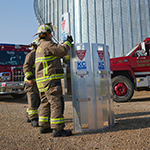Frostbite dangers
Learn the signs and treatment for frostbite.
Working outside in cold temperatures is a reality for many agribusiness workers. Beyond just being uncomfortable, outdoor work in extreme cold is dangerous due to the threat of frostbite, which can cause serious damage to skin and other tissues. In severe cases, frostbite may require amputation of the affected area. That’s why it’s important to recognize and heed the warning signs of frostbite before the condition becomes severe.
What does frostbite look like?
- Redness and pain are the early symptoms — more advanced signs include a white or grayish-yellow tone to the affected area.
- Skin may feel unusually waxy or firm.
- Frozen tissue becomes numb — victims of frostbite may be unaware of the seriousness of their condition until someone else points it out.
When symptoms of frostbite develop, the victim requires emergency medical care. If professional help isn’t readily available, take these actions:
- Get the victim to a warm place as quickly as possible.
- Do not allow a victim to walk on frost-bitten feet or toes (unless it’s unavoidable).
- Immerse the affected skin into warm, not hot, water
- Use body heat to help warm affected skin — for example, place frostbitten fingers under an armpit.
- Never rub the affected area or use a heating pad, heat lamp, or heat from a stove, fireplace, or radiator to warm the skin, as they can cause burns.
Just how susceptible are people to cold-related health problems?
The answer depends on a number of factors, including a person’s age and physical condition, outdoor temperature, wind conditions and humidity. In extreme conditions, it’s best to stay inside. But if you must spend part of your workday in a cold environment, make sure you dress appropriately.
- Dress in layers — doing so not only creates additional insulation, but enables you to adjust to changing conditions.
- Wear a hat — preferably one that covers the ears. Most body heat escapes through the head.
- Wear waterproof, insulated boots — they’ll keep feet warm and dry and help you maintain proper footing in snowy or icy conditions.
- Remove wet clothing immediately — keep blankets and a change of clothing accessible.
- Drink warm fluids such as soup or cider — avoid beverages that contain caffeine or alcohol.

 >
>

 >
>
 >
>